On the Radon-Related Mechanism of the Seismo- and Volcanogenic Geomagnetic Anomalies: Experiments in Tlamacas Mountain (Volcano Popocatepetl Area) and Electrode Effect Model
Abstract
1. Introduction
2. Experiment and Results
2.1. Geomagnetic Field Measurements
2.1.1. Methodology
2.1.2. Results
2.2. Radon-Related Measurements
2.2.1. Methodology
2.2.2. Results
- -
- The radon release in the Tlamacas Mountain (up to 5000 Bq/m3) is significantly higher than in any other referent site;
- -
- It is much higher than in the other areas of the volcano Popocatepetl;
- -
- The origin of the radon in Tlamacas is caused by natural degassing in addition to the radioactive soil deposits detected in other volcano sites;
- -
- Tlamacas Mountain can be considered as a natural reactor and a powerful source of ionization that modifies the atmosphere electricity vertical profile.
3. Air Ionization Produced by Radon and Large Hydrated Clusters Formation
4. Model
5. Discussion
6. Conclusions
Author Contributions
Funding
Institutional Review Board Statement
Informed Consent Statement
Data Availability Statement
Acknowledgments
Conflicts of Interest
References
- Braile, L.W.; Keller, G.R.; Hinze, W.J.; Lidiak, E.G. An ancient rift complex and its relation to contemporary seismicity in the New Madrid seismic zone. Tectonics 1982, 1, 225–237. [Google Scholar] [CrossRef]
- LiveScience; Lloyd, R. Source of Major Quakes Discovered Beneath U.S. Heartland. 2 May 2007. Available online: http://www.livescience.com/environment/070502_newmadrid_quake.html (accessed on 9 September 2008).
- Brogi, A.; Capezzuoli, E.; Alçiçek, M.C.; Gandin, A. Evolution of a fault-controlled fissure-ridge type travertine deposit in the western Anatolia extensional province: The Çukurbağ fissureridge (Pamukkale, Turkey). J. Geol. Soc. 2014, 171, 425–441. [Google Scholar] [CrossRef]
- Çakir, Z. Along-strike discontinuity of active normal faults and its influence on quaternary travertine deposition; examples from western Turkey. Turk. J. Earth Sci. 2014, 8, 67–80. [Google Scholar]
- Stein, S.; Cloetingh, S.; Sleep, N.H.; Wortel, R. Passive margin earthquakes, stresses and rheology. In Earthquakes at North-Atlantic Passive Margins: Neotectonics and Postglacial Rebound; Gregerson, S., Basham, P., Eds.; Kluwer: Dordecht, The Netherlands, 1989; pp. 231–260. [Google Scholar]
- Talwani, P. (Ed.) Intraplate Earthquakes; Cambridge University Press & Assessment: Cambridge, UK, 2018; ISBN 978-1-107-04038-0. [Google Scholar]
- Chen, C.; Gilbert, H.; Andronicos, C.; Hamburger, M.W.; Larson, T.; Marshak, S.; Pavlis, G.L.; Yang, X. Shear velocity structure beneath the central United States: Implications for the origin of the Illinois Basin and intraplate seismicity. Geochem. Geophys. Geosyst. 2016, 17, 1020–1041. [Google Scholar] [CrossRef]
- Ghosh, A.; Holt, W.E.; Bahadori, A. Role of large-scale tectonic forces in intraplate earthquakes of Central and Eastern North America. Geochem. Geophys. Geosyst. 2019, 20, 2134–2156. [Google Scholar] [CrossRef]
- Schulte, S.; Mooney, W.D. An updated global earthquake catalogue for stable continental regions: Reassessing the correlation with ancient rifts. Geophys. J. Int. 2005, 161, 707–721. [Google Scholar] [CrossRef]
- Sykes, L. Intraplate seismicity, reactivation of preexisting zones of weakness, alkaline magmatism, and other tectonism postdating continental fragmentation. Rev. Geophys. 1978, 16, 621–688. [Google Scholar] [CrossRef]
- Tarduno, J.A.; Duncan, R.A.; Scholl, D.W.; Cottrell, R.D.; Steinberger, B.; Thordarson, T.; Kerr, B.C.; Neal, C.R.; Frey, F.A.; Torii, M.; et al. The Emperor Seamounts: Southward Motion of the Hawaiian Hotspot Plume in Earth’s Mantle. Science 2003, 301, 1064–1069. [Google Scholar] [CrossRef]
- Soman, V.R. Hot Times in Tectonophysics: Mantle Plume Dynamics and Magmatic Perturbances. J. Environ. Ecol. 2020, 11, 19. [Google Scholar] [CrossRef]
- Koppers, A.; Yamazaki, T.; Geldmacher, J.; Gee, J.; Pressling, N.; Hoshi, H.; Anderson, L.; Beier, C.; Buchs, D.; Chen, L.-H.; et al. Limited latitudinal mantle plume motion for the Louisville hotspot. Nat. Geosci. 2012, 5, 911–917. [Google Scholar] [CrossRef]
- Konrad, K.; Koppers, A.A.P.; Steinberger, B.; Finlayson, V.A.; Konter, J.G.; Jackson, M.G. On the relative motions of long-lived Pacific mantle plumes. Nat. Commun. 2018, 9, 854. [Google Scholar] [CrossRef] [PubMed]
- Bono, R.K.; Tarduno, J.A.; Bunge, H.P. Hotspot Motion caused the Hawaiian-Emperor Bend and LLSVPs are not fixed. Nat. Commun. 2019, 10, 3370. [Google Scholar] [CrossRef] [PubMed]
- Lee, C.T.; Grand, S. Intraplate volcanism. Nature 2012, 482, 314–315. [Google Scholar] [CrossRef] [PubMed]
- Coffin, M.F.; Whittaker, J.M. Intraplate Magmatism. In Encyclopedia of Marine Geosciences; Springer Science+Business Media: Dordrecht, The Netherlands, 2015. [Google Scholar] [CrossRef]
- Aranda-Gómez, J.J.; Luhr, J.F.; Housh, T.B.; Valdez-Moreno, G.; Chávez-Cabello, G. El volcanismo tipo intraplaca del Cenozoico tardío en el centro y norte de México: Una revisión. Boletín Soc. Geológica Mex. 2005, 57, 187–225. [Google Scholar] [CrossRef]
- Díaz-Bravo, B.A.; Gómez-Tuena, A.; Ortega-Obregón, C.; Pérez-Arvizu, O. The origin of intraplate magmatism in the western Trans-Mexican Volcanic Belt. Geosphere 2014, 10, 340–373. [Google Scholar] [CrossRef]
- Kuritani, T.; Kimura, J.-I.; Miyamoto, T.; Wei, H.; Shimano, T.; Maeno, F.; Jin, X.; Taniguchi, H. Intraplate magmatism related to deceleration of upwelling asthenospheric mantle: Implications from the Changbaishan shield basalts, northeast China. Lithos 2009, 112, 247–258. [Google Scholar] [CrossRef]
- Johnston, A.C.; Kanter, L.R. Earthquakes in stable continental crust. Sci. Am. 1990, 262, 42–49. [Google Scholar] [CrossRef]
- Forte, A.M.; Mitrovica, J.X.; Moucha, R.; Simmons, N.A.; Grand, S.P. Descent of the ancient Farallon slab drives localized mantle flow below the New Madrid seismic zone. Geophys. Res. Lett. 2007, 34, L04308. [Google Scholar] [CrossRef]
- Ball, P.W.; White, N.J.; Maclennan, J.; Stephenson, S.N. Global influence of mantle temperature and plate thickness on intraplate volcanism. Nat. Commun. 2021, 12, 2045. [Google Scholar] [CrossRef]
- Klöcking, M.; White, N.J.; Maclennan, J.; McKenzie, D.; Fitton, J.G. Quantitative relationships between basalt geochemistry, shear wave velocity, and asthenospheric temperature beneath western North America. Geochem. Geophys. Geosyst. 2018, 19, 3376–3404. [Google Scholar] [CrossRef]
- Surkov, V.V. Pre-seismic variations of atmospheric radon activity as a possible reason for abnormal atmospheric effects. Ann. Geophys. 2015, 58, A0554. [Google Scholar] [CrossRef]
- Cinelli, G.; Tositti, L.; Capaccioni, B.; Brattich, E.; Mostacci, D. Soil gas radon assessment and development of a radon risk map in Bolsena, Central Italy. Environ. Geochem. Health 2015, 37, 305–319. [Google Scholar] [CrossRef] [PubMed]
- Sharma, S.; Kumar, A.; Mehra, R.; Mishra, R. Assessment of Soil Gas Radon and Exhalation Studies in Lower Himalayan Region of Jammu and Kashmir State, India. Pure Appl. Geophys. 2018, 175, 4411–4426. [Google Scholar] [CrossRef]
- Neri, M.; Ferrera, E.; Giammanco, S.; Currenti, G.; Cirrincione, R.; Patanè, G.; Zanon, V. Soil radon measurements as a potential tracer of tectonic and volcanic activity. Sci. Rep. 2016, 6, 24581. [Google Scholar] [CrossRef]
- Kulalı, F.; Akkurt, I.; Özgür, N.; Sezer, M. The correlation of the seismic activities and radon concentration in soil gas. Arab. J. Geosci. 2018, 11, 447. [Google Scholar] [CrossRef]
- Ferrari, L.; Castillo-Reynoso, J.C.; Orozco-Esquivel, T.; Silva-Fragoso, A. Digital geologic map and geochronologic, geochemical and geothermal database of the south-eastern part of the Sierra Madre Occidental, Mexico. Terra Digit. 2018, 2, 1–6. [Google Scholar] [CrossRef]
- Jácome Paz, M.P.; Pérez-Zarate, D.; Prol-Ledesma, R.M.; González Romo, I.; Rodríguez, A. Geochemical exploration in Mesillas geothermal area, Mexico. Appl. Geochem. 2022, 143, 105376. [Google Scholar] [CrossRef]
- Prol-Ledesma, R.M.; Morán-Zenteno, D.J. Heat flow and geothermal provinces in Mexico. Geothermics 2019, 78, 183–200. [Google Scholar] [CrossRef]
- Arango-Galván, C.; Prol-Ledesma, R.M.; Torres-Vera, M.A. Geothermal prospects in the Baja California Peninsula. Geothermics 2015, 55, 39–57. [Google Scholar] [CrossRef]
- Macías Vásquez, J.L.; Carrasco Núñez, G.; Delgado Granados, H. Mapa de Peligros del Volcán Popocatepetl; Instituto de Geofísica, UNAM: Ciudad De México, México, 1995; Available online: http://tornado.cenapred.unam.mx/es/Instrumentacion/InstVolcaca/MVolcan/ImagenesMVolcan/mapaPeligrosA.jpg (accessed on 15 December 2022).
- Macías, J.L. Geología e historia eruptiva de algunos de los grandes volcanes activos de México. Boletín Soc. Geológica Mex. 2005, 57, 379–424. [Google Scholar] [CrossRef]
- Kotsarenko, A.; Pérez Enríquez, R.; López Cruz-Abeyro, J.A.; Koshova, S.; Grimalsky, V. Analysis of the ULF electromagnetic emission related to seismic activity, Teoloyucan geomagnetic station, 1998–2001. Nat. Hazards Earth Syst. Sci. (NHESS) 2004, 4, 679–684. [Google Scholar] [CrossRef]
- Kotsarenko, A.; Grimalsky, V.; Pérez Enríquez, R.; Valdez-González, C.; Koshevaya, S.; López Cruz-Abeyro, J.A.; Yutsis, V. Volcano Popocatepetl, Mexico: ULF geomagnetic anomalies observed at Tlamacas station during March–July 2005. Nat. Hazards Earth Syst. Sci. (NHESS) 2007, 7, 103–107. [Google Scholar] [CrossRef]
- Kotsarenko, A.; Pérez Enríquez, R.; López Cruz-Abeyro, J.A.; Koshevaya, S.; Grimalsky, V.; Yutsis, V.; Kremenetsky, I. ULF geomagnetic anomalies of possible seismogenic origin observed at Teoloyucan station, México, in 1999–2001: Intermediate and Short-Time Analysis. Tectonophysics 2007, 431, 249–262. [Google Scholar] [CrossRef]
- Kotsarenko, A.; Grimalsky, V.; Pérez Enríquez, R.; Yutsis, V.; Koshevaya, S.; Lopez Cruz-Abeyro, J.A.; Valdez-Gonzalez, C.; Villegas Cerón, R.A. Geomagnetic anomalies observed at volcano Popocatepetl, Mexico. Adv. Geosci. 2008, 14, 21–24. [Google Scholar] [CrossRef]
- Kotsarenko, A.; Grimalsky, V.; Yutsis, V.; Medina Pérez, L.I.; Bravo Osuna, A.G.; Koshevaya, S.; Peréz Enríquez, H.R.; Urquiza Beltrán, G.; Villegas Cerón, R.A.; Lopez Cruz Abeyro, J.A.; et al. Experimental studies of anomalous Radon activity in the Tlamacas mountain, volcano Popocatepetl area, Mexico: New tools to study Litosphere-Atmosphere coupling for forecasting volcanic and seismic events. Ann. Geophys. 2012, 55, 109–118. [Google Scholar] [CrossRef]
- Kotsarenko, A.; Yutsis, V.; Grimalsky, V.; Koshevaya, S. Detailed Study of Radon Spatial Anomaly in Tlamacas Mountain Area, Volcano Popocatepetl, Mexico. Open J. Geol. 2016, 6, 158–164. [Google Scholar] [CrossRef]
- Kotsarenko, A.; Yutsis, V.; Grimalsky, V.; Koshevaya, S.; Kotsarenko, Y. Geomagnetic anomalies in the area of volcano Popocatepetl, Mexico. Geofis. Int. 2019, 58, 101–111. [Google Scholar] [CrossRef]
- Kotsarenko, A.; Yutsis, V.; Grimalsky, V.; Koshevaya, S.; Kotsarenko, Y. Anomalous temperature regimen in the near-surface soil layer of Tlamacas hill and its relation to activity of Popocatépetl Volcano, Mexico. BSGF—Earth Sci. Bull. 2020, 191, 3. [Google Scholar] [CrossRef]
- Chi, P.J.; McMAC Team. Observations by Mid-continent Magnetoseismic Chain (McMAC) and their use in space weather research. In Proceedings of the 36th COSPAR Scientific Assembly, Beijing, China, 16–23 July 2006; Available online: http://www.cosis.net/abstracts/COSPAR2006/02530/COSPAR2006-A-02530-1.pdf (accessed on 15 December 2022).
- Iwata, D.; Nagahama, H.; Muto, J.; Yasuoka, Y. Non-parametric detection of atmospheric radon concentration anomalies related to earthquakes. Sci. Rep. 2018, 8, 13028. [Google Scholar] [CrossRef] [PubMed]
- D’Incecco, S.; Petraki, E.; Priniotakis, G.; Papoutsidakis, M.; Yannakopoulos, P.; Nikolopoulos, D. CO2 and Radon Emissions as Precursors of Seismic Activity. Earth Syst. Environ. 2021, 5, 655–666. [Google Scholar] [CrossRef]
- Woith, H. Radon earthquake precursor: A short review. Eur. Phys. J. Spec. Top. 2015, 224, 611–627. [Google Scholar] [CrossRef]
- Alam, A.; Wang, N.; Zhao, G.; Barkat, A. Implication of Radon Monitoring for Earthquake Surveillance Using Statistical Techniques: A Case Study of Wenchuan Earthquake. Geofluids 2020, 2020, 2429165. [Google Scholar] [CrossRef]
- Ingebritsen, S.E.; Manga, M. Hydrogeochemical precursors. Nat. Geosci. 2014, 7, 697–698. [Google Scholar] [CrossRef]
- Barkat, A.; Ali, A.; Hayat, U.; Crowley, Q.G.; Rehman, K.; Siddique, N.; Haidar, T.; Iqbal, T. Time series analysis of soil radon in northern Pakistan: Implications for earthquake forecasting. Appl. Geochem. 2018, 97, 197–208. [Google Scholar] [CrossRef]
- Nazaroff, W.W. Radon transport from soil to air. Rev. Geophys. 1992, 30, 137–160. [Google Scholar] [CrossRef]
- Muto, J.; Yasuoka, Y.; Miura, N.; Iwata, D.; Nagahama, H.; Hirano, M.; Ohmomo, Y.; Mukai, T. Preseismic atmospheric radon anomaly associated with 2018 Northern Osaka earthquake. Sci. Rep. 2021, 11, 7451. [Google Scholar] [CrossRef]
- Zhou, Z.; Tian, L.; Zhao, J.; Wang, H.; Liu, J. Stress-Related Pre-Seismic Water Radon Concentration Variations in the Panjin Observation Well, China (1994–2020). Front. Earth Sci. 2020, 8, 596283. [Google Scholar] [CrossRef]
- Fu, C.; Yang, T.; Tsai, M.; Lee, L.; Liu, T.; Walia, V.; Chen, C.; Chang, W.; Kumar, A.; Lai, T. Exploring the relationship between soil degassing and seismic activity by continuous radon monitoring in the Longitudinal Valley of eastern Taiwan. Chem. Geol. 2017, 469, 163–175. [Google Scholar] [CrossRef]
- Zmazek, B.; Živcic, M.; Todorovski, L.; Džeroski, S.; Janja Vaupotic, J.; Kobal, I. Radon Anomalies in Soil Gas Caused by Seismic Activity. Acta Geotech. Slov. 2004, 1, 13–19. [Google Scholar]
- Zenginerler, Z.; Ertugrul, F.; Yakut, H.; Tabar, E.; Demirci, N.; Gunermelikoglu, K. Measurement of seasonal indoor radon concentration in Sakarya University, Turkey. Acta Phys. Pol. A 2016, 130, 450–452. [Google Scholar] [CrossRef]
- Hoppel, W.A.; Anderson, R.V.; Willett, J.C. Atmospheric Electricity in the Planetary Boundary Layer. In The Earth’s Electrical Envirinment; Studies in Geophysics; National Academy Press: Washington, DC, USA, 1986; pp. 149–165. [Google Scholar]
- Pulinets, S.; Ouzounov, D.; Karelin, A.; Boyarchuk, K. Earthquake Precursors in the Atmosphere and Ionosphere. New Concepts; Springer Nature: Dordrecht, The Netherlands, 2023; 312p. [Google Scholar] [CrossRef]
- Kobeissi, M.A.; Gomez, F.; Tabet, C. Measurement of anomalous radon gas emanation across the Yammouneh Fault in Southern Lebanon: A possible approach to earthquake prediction. Int. J. Disaster Risk Sci. 2015, 6, 250–266. [Google Scholar] [CrossRef]
- Pulinets, S.A.; Boyarchuk, K.A. Ionospheric Precursors of Earthquakes; Springer: Berlin/Heidelberg, Germany; New York, NY, USA, 2004; 315p. [Google Scholar] [CrossRef]
- Pulinets, S.; Budnikov, P.; Karelin, A.; Žalohar, J. Thermodynamic instability of the atmospheric boundary layer stimulated by tectonic and seismic activity. J. Atmos. Sol.-Terr. Phys. 2023, 106050. [Google Scholar] [CrossRef]
- Kikuchi, H. Electrohydrodynamics in Dusty and Dirty Plasmas: Gravito-Electrodynamics and EHD; Springer: Dordrecht, The Netherlands, 2001; 207p. [Google Scholar] [CrossRef]
- Hoppel, W.A. Theory of Electrode Effect. J. Atmosph. Terrestr. Phys. 1967, 29, 709–721. [Google Scholar] [CrossRef]
- Willet, J.C. Fair-Weather Electric Charge Transfer by Convection in an Unstable Boundary Layer. J. Geophys. Res. Ocean. 1979, 84, 703–718. [Google Scholar] [CrossRef]
- Seropian, G.; Kennedy, B.M.; Walter, T.R.; Ichihara, M.; Jolly, A.D. A review framework of how earthquakes trigger volcanic eruptions. Nat. Commun. 2021, 12, 1004. [Google Scholar] [CrossRef]
- Farías, C.; Galván, B.; Miller, S.A. Numerical simulations (2D) on the influence of pre-existing local structures and seismic source characteristics in earthquake-volcano interactions. J. Volcanol. Geotherm. Res. 2017, 343, 192–210. [Google Scholar] [CrossRef]
- Linde, A.T.; Sacks, I.S. Triggering of volcanic eruptions. Nature 1998, 395, 888–890. [Google Scholar] [CrossRef]
- Manga, M.; Brodsky, E. Seismic triggering of eruptions in the far field: Volcanoes and geysers. Annu. Rev. Earth Planet. Sci. 2006, 34, 263–291. [Google Scholar] [CrossRef]
- Namiki, A.; Rivalta, E.; Woith, H.; Walter, T.R. Sloshing of a bubbly magma reservoir as a mechanism of triggered eruptions. J. Volcanol. Geotherm. Res. 2016, 320, 156–171. [Google Scholar] [CrossRef]
- Vargas, C.A.; Koulakov, I.; Jaupart, C.; Gladkov, V.; Gomez, E.; El Khrepy, S.; Al-Arifi, N. Breathing of the Nevado del Ruiz volcano reservoir, Colombia, inferred from repeated seismic tomography. Sci. Rep. 2017, 7, 46094. [Google Scholar] [CrossRef]
- Archer, M.O.; Hartinger, M.D.; Rastätter, L.; Southwood, D.J.; Heyns, M.; Eggington, J.W.B.; Wright, A.N.; Plaschke, F.; Shi, X. Auroral, ionospheric and ground magnetic signatures of magnetopause surface modes. J. Geophys. Res. Space Phys. 2023, 128, e2022JA031081. [Google Scholar] [CrossRef]
- Keiling, A. Alfvén waves and their roles in the dynamics of the earth’s magnetotail: A review. Space Sci. Rev. 2009, 142, 73–156. [Google Scholar] [CrossRef]
- Heyns, M.J.; Lotz, S.I.; Gaunt, C.T. Geomagnetic pulsations driving geomagnetically induced currents. Space Weather 2021, 19, e2020SW002557. [Google Scholar] [CrossRef]
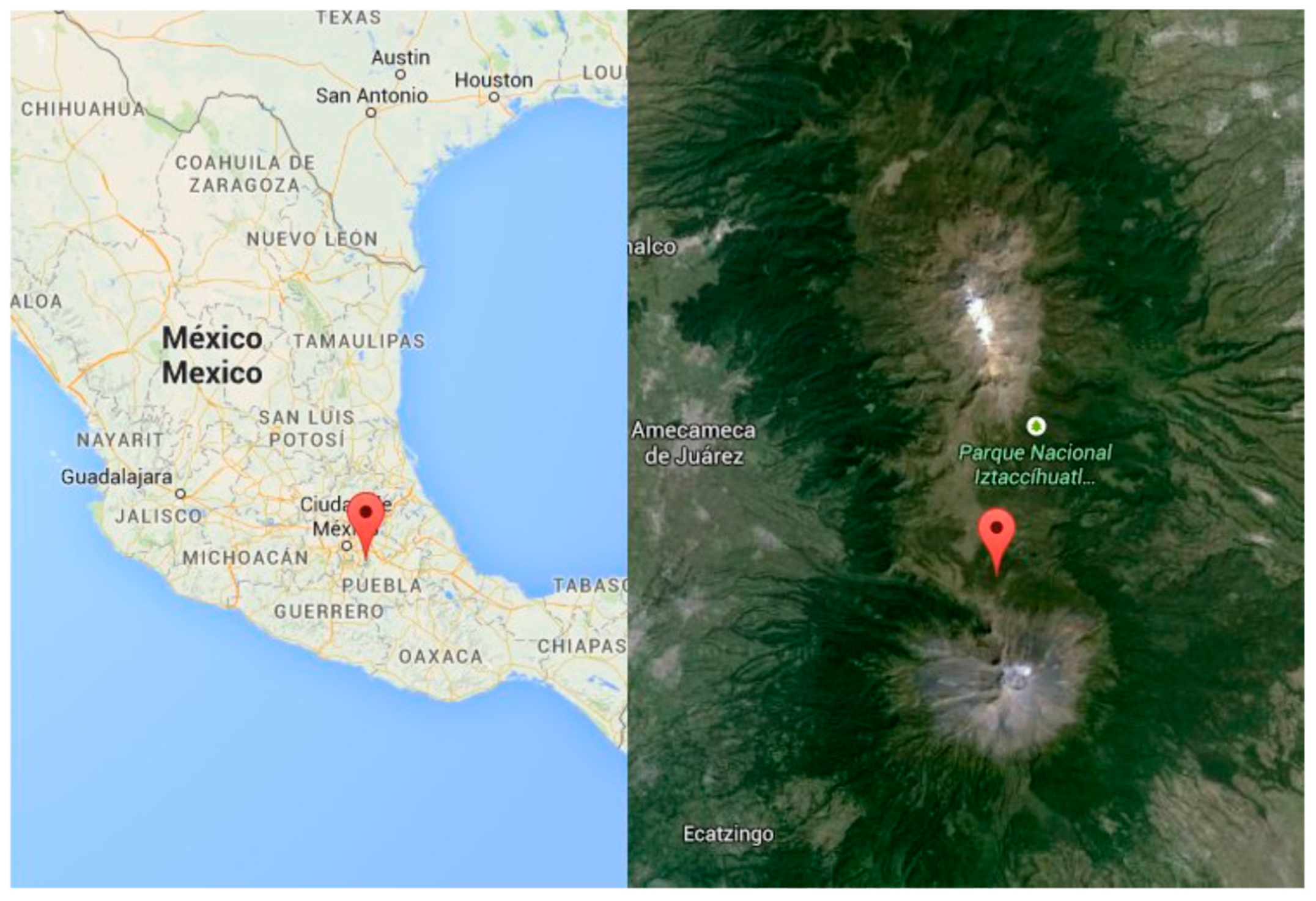


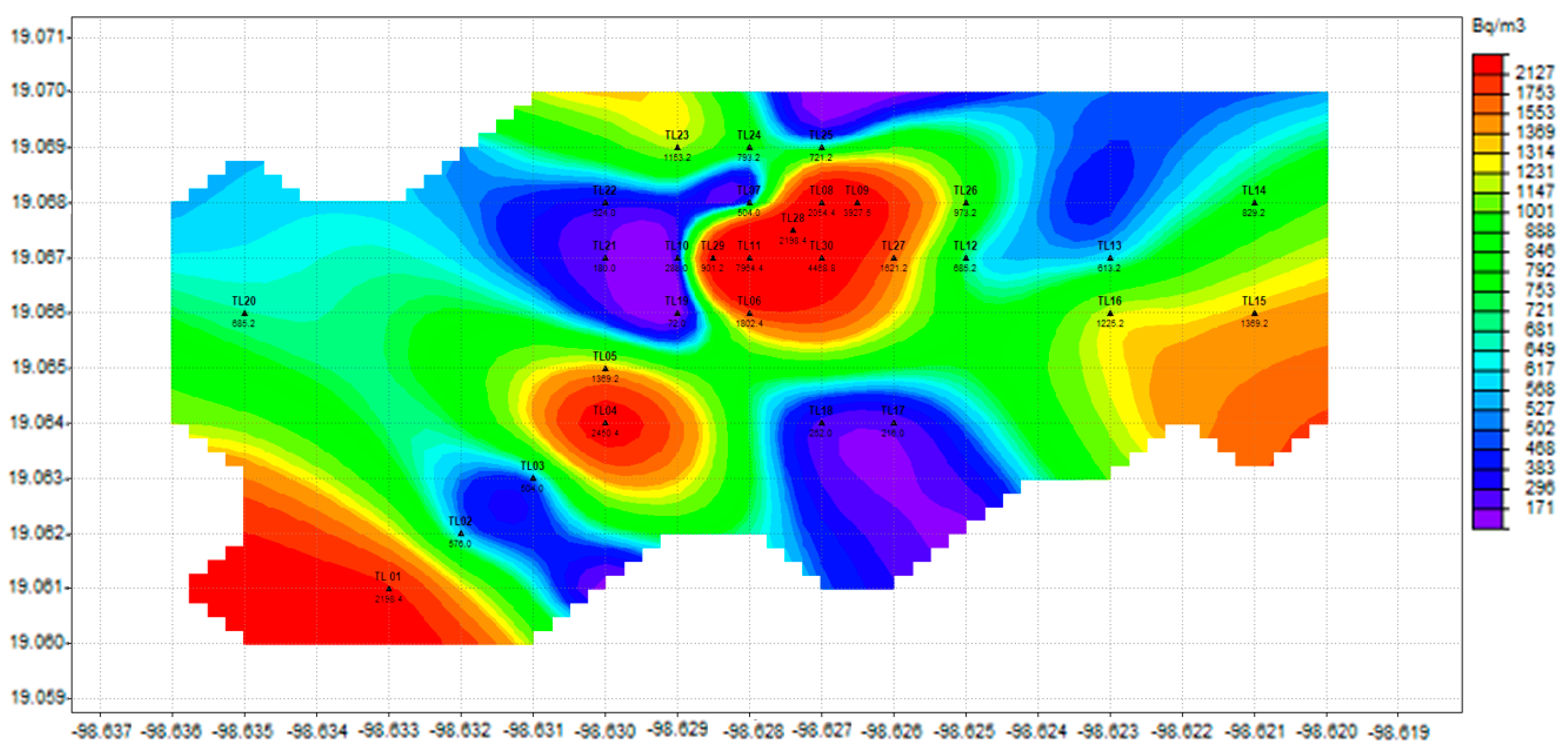
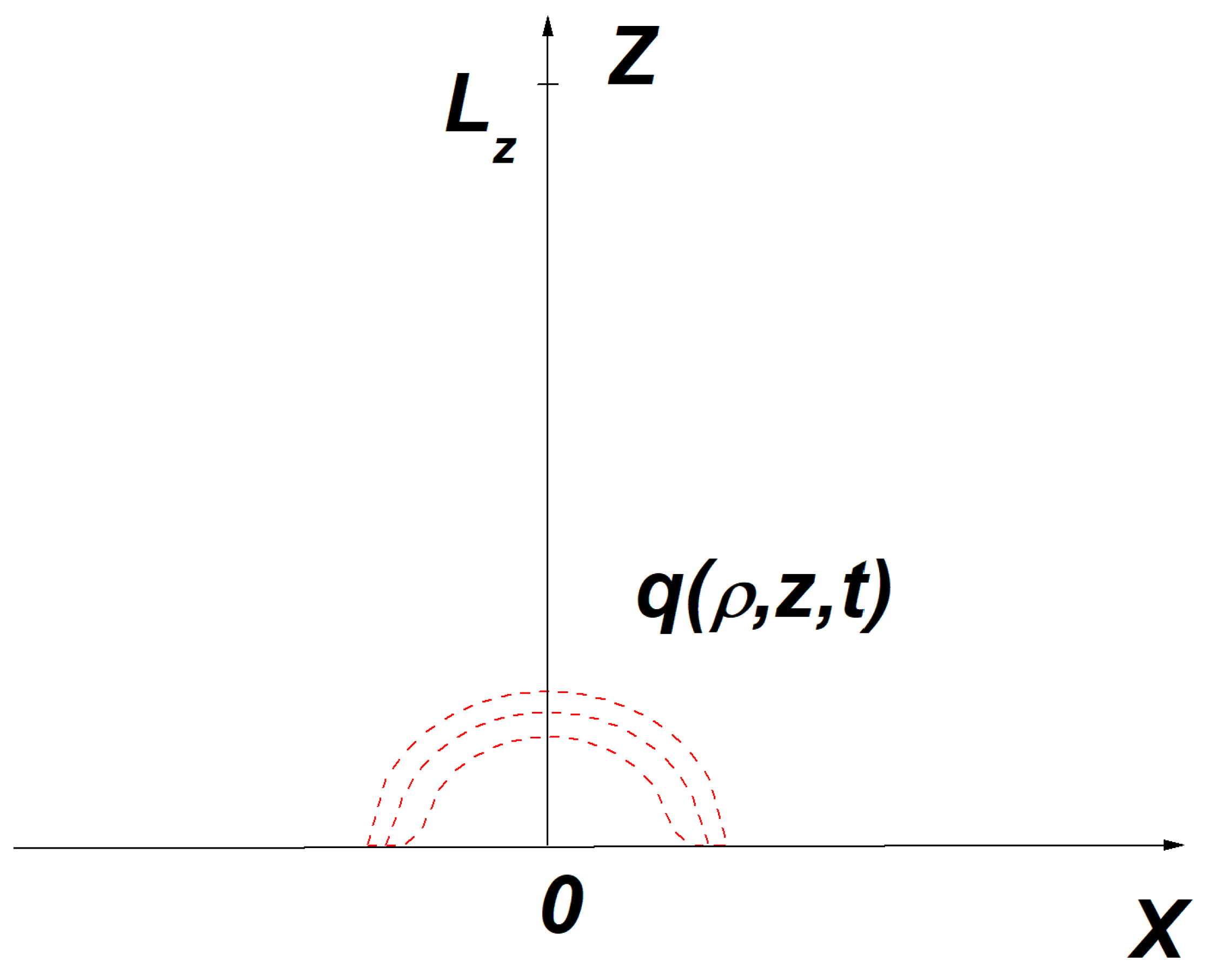
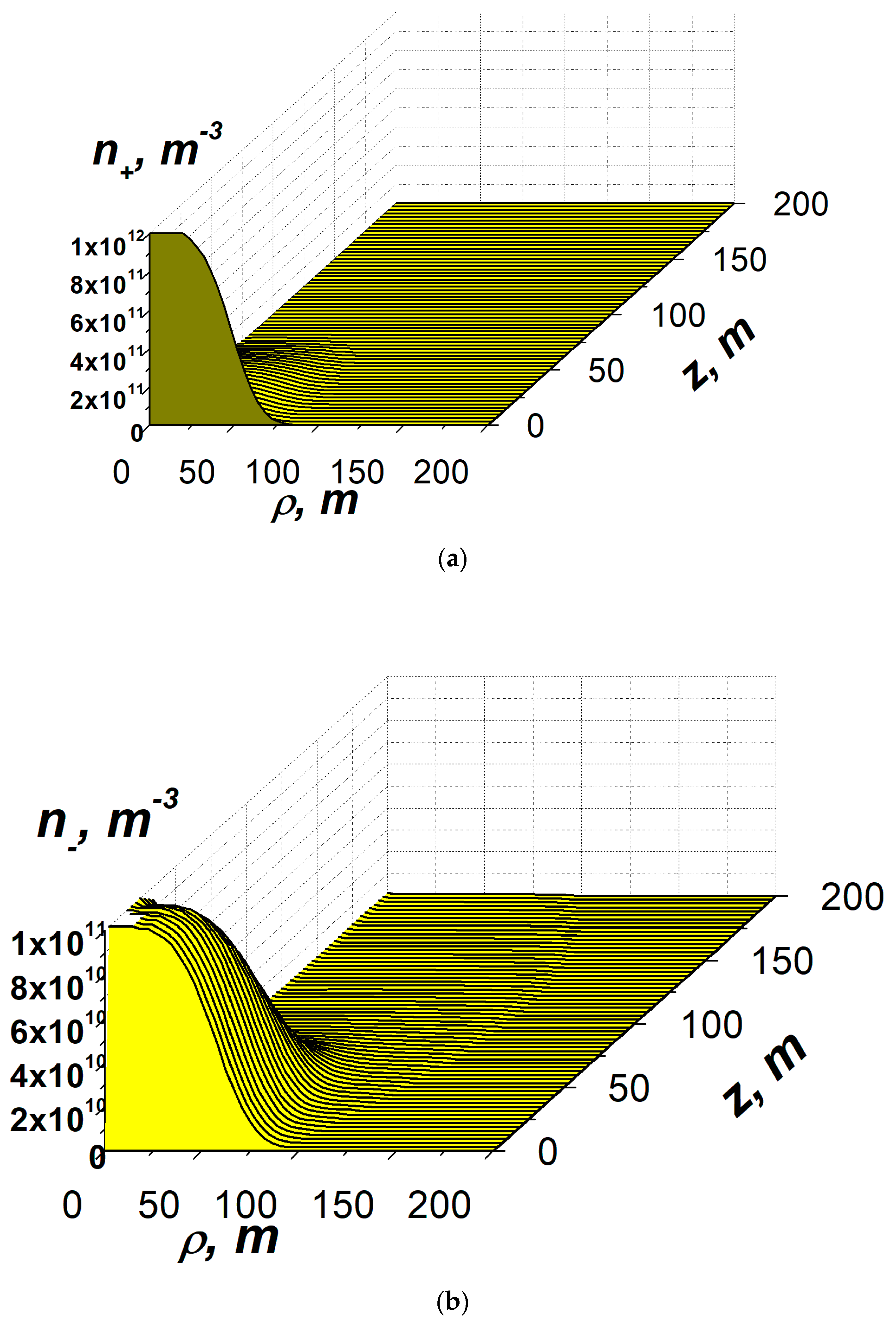
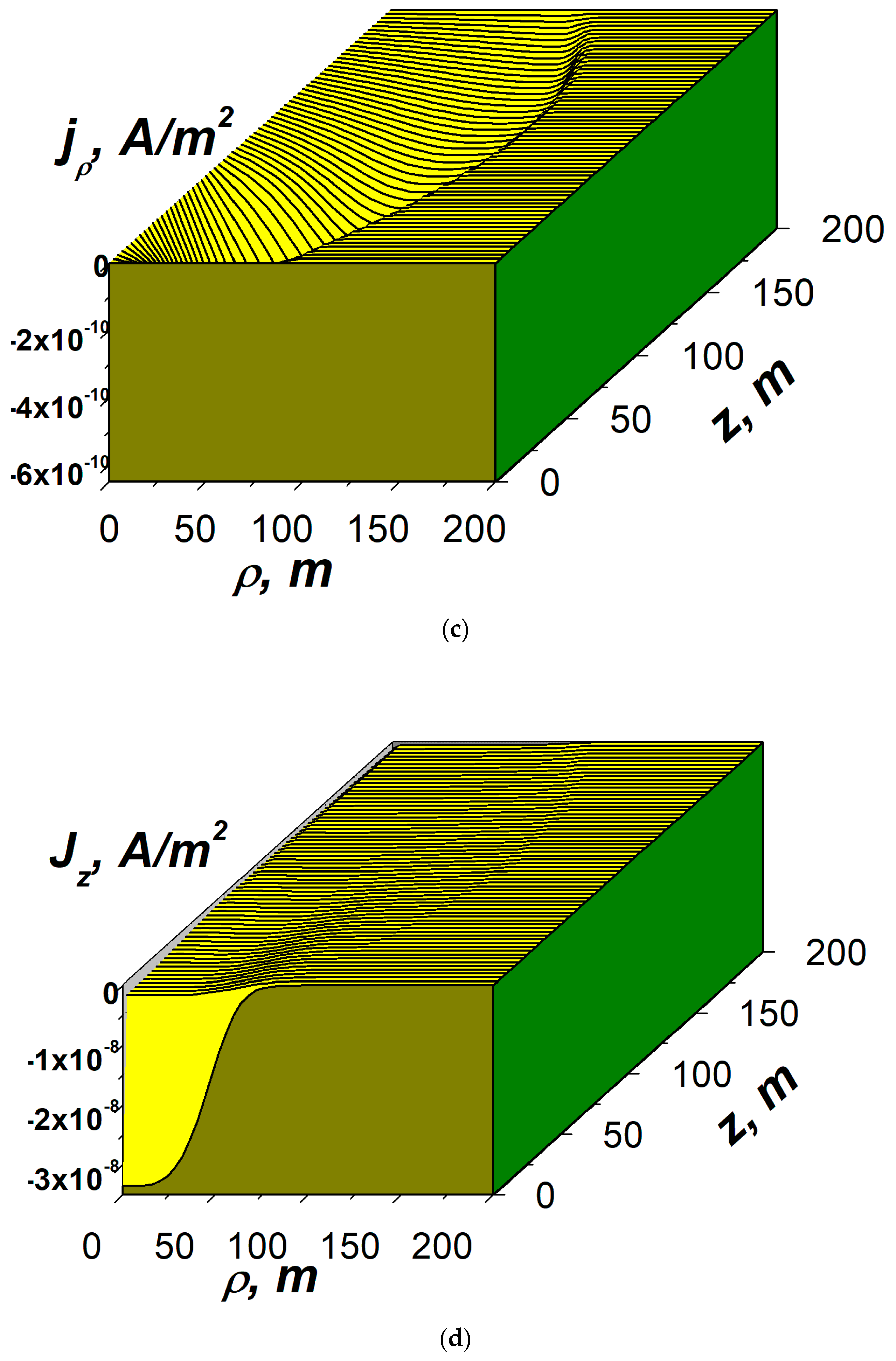
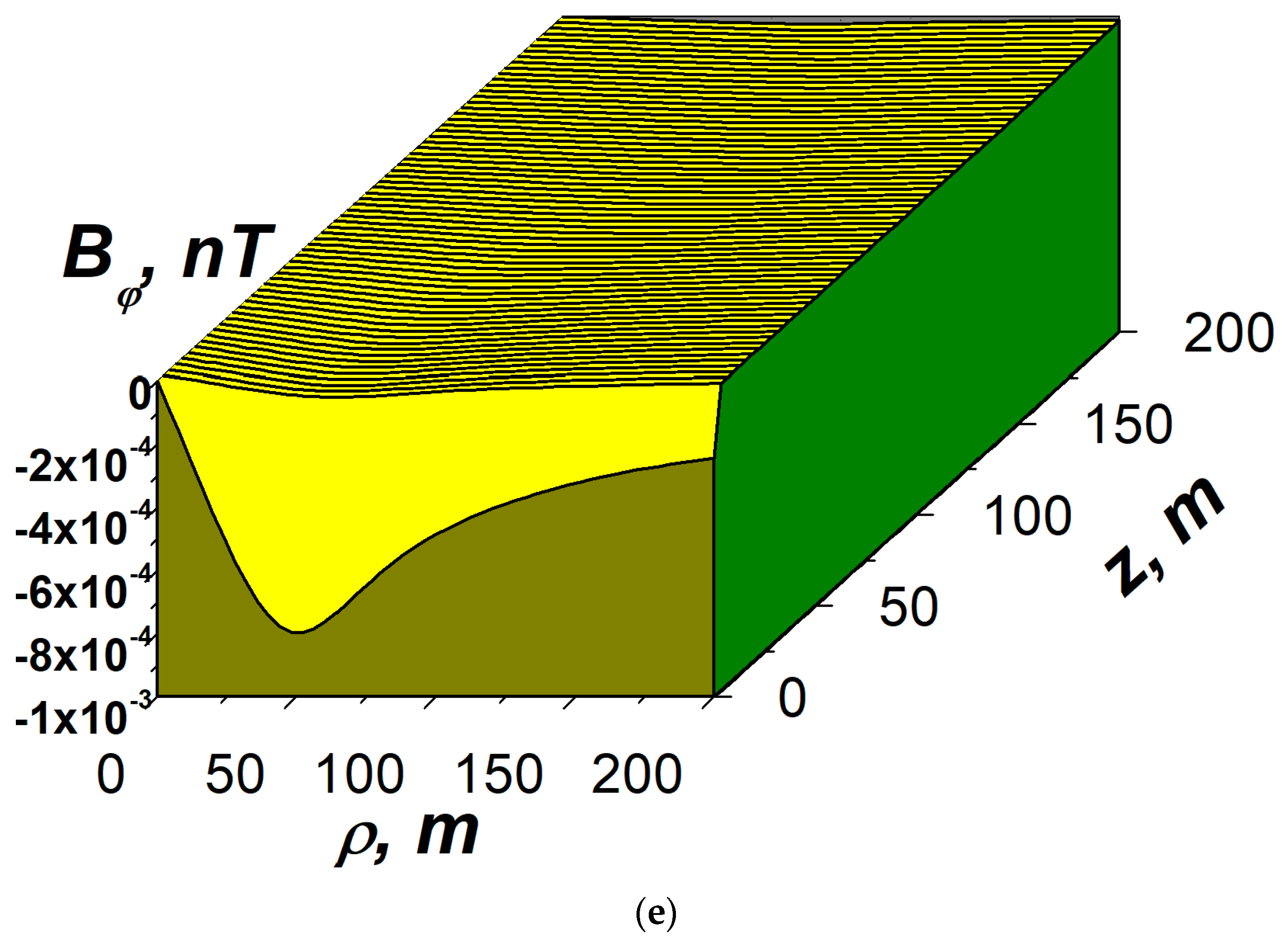
Disclaimer/Publisher’s Note: The statements, opinions and data contained in all publications are solely those of the individual author(s) and contributor(s) and not of MDPI and/or the editor(s). MDPI and/or the editor(s) disclaim responsibility for any injury to people or property resulting from any ideas, methods, instructions or products referred to in the content. |
© 2023 by the authors. Licensee MDPI, Basel, Switzerland. This article is an open access article distributed under the terms and conditions of the Creative Commons Attribution (CC BY) license (https://creativecommons.org/licenses/by/4.0/).
Share and Cite
Yutsis, V.; Kotsarenko, A.; Grimalsky, V.; Pulinets, S. On the Radon-Related Mechanism of the Seismo- and Volcanogenic Geomagnetic Anomalies: Experiments in Tlamacas Mountain (Volcano Popocatepetl Area) and Electrode Effect Model. Atmosphere 2023, 14, 705. https://doi.org/10.3390/atmos14040705
Yutsis V, Kotsarenko A, Grimalsky V, Pulinets S. On the Radon-Related Mechanism of the Seismo- and Volcanogenic Geomagnetic Anomalies: Experiments in Tlamacas Mountain (Volcano Popocatepetl Area) and Electrode Effect Model. Atmosphere. 2023; 14(4):705. https://doi.org/10.3390/atmos14040705
Chicago/Turabian StyleYutsis, Vsevolod, Anatolyi Kotsarenko, Vladimir Grimalsky, and Sergey Pulinets. 2023. "On the Radon-Related Mechanism of the Seismo- and Volcanogenic Geomagnetic Anomalies: Experiments in Tlamacas Mountain (Volcano Popocatepetl Area) and Electrode Effect Model" Atmosphere 14, no. 4: 705. https://doi.org/10.3390/atmos14040705
APA StyleYutsis, V., Kotsarenko, A., Grimalsky, V., & Pulinets, S. (2023). On the Radon-Related Mechanism of the Seismo- and Volcanogenic Geomagnetic Anomalies: Experiments in Tlamacas Mountain (Volcano Popocatepetl Area) and Electrode Effect Model. Atmosphere, 14(4), 705. https://doi.org/10.3390/atmos14040705






